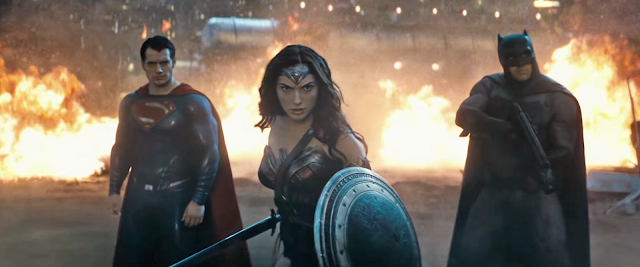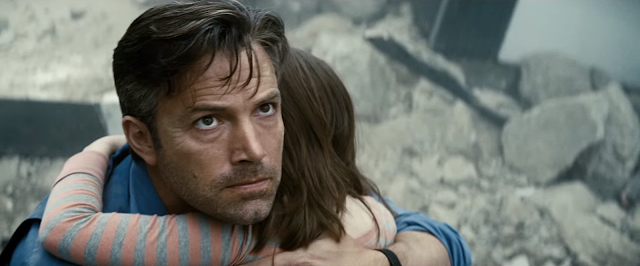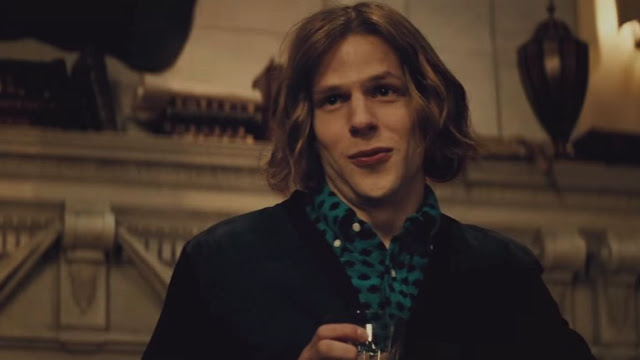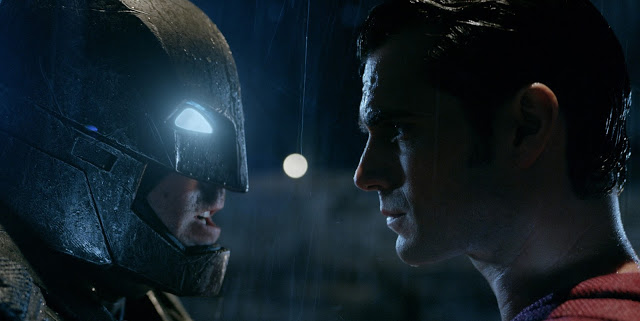“Nobody cares about Clark Kent taking on the Batman,” Perry White scoffs midway through Batman v Superman: Dawn of Justice, the long, lumbering, sporadically pleasing genre behemoth from Warner Brothers. Perry (Laurence Fishburne) is the editor-in-chief of The Daily Planet, but while he may be a decent newsman, he’d make a lousy studio executive. The honchos at Warner Bros. are quite confident that everyone—or, at least, a sizeable percentage of the ticket-buying populace—is intrigued by a faceoff between a bespectacled reporter and a caped vigilante, so much so that they’re banking on this $250 million seedling to flower into the Justice League, a confederation designed to rival Marvel’s unstoppable Avengers franchise. As with most modern superhero movies, this one feels less created than engineered, and you can see its readymade headline from space: Batman fights Superman, while Wonder Woman looks on in a skimpy outfit. Perry White just sold out three printings.
Now, I do not begrudge a business for trying to make money. To accuse Warner Bros. of profiting off the quenchless thirst of Batman and Superman’s fanboys is to chastise a lion for mauling a gazelle. But while the studio will view this film primarily as a savior to its balance sheet, the question remains just what kind of movie it is. And the answer, ironically enough, appears right there on the campaign’s promotional materials: It’s a movie directed by Zack Snyder.
The 50-year-old Snyder, who has been adapting comic books and graphic novels for Warner Bros. for the better part of a decade—he broke into the studio ranks with the witless smash 300, though his commercial prospects took a hit with the crazily ambitious Watchmen—is a devotee of darkness; his films are (theoretically) about tortured men struggling with the weight of their own power. They are also loud, long, and largely joyless, none more so than Man of Steel, the misbegotten Superman reboot that served as a clunky precursor to this film (which, in turn, serves as a precursor to next year’s Justice League: Part One). A clanking, senseless exercise in testosterone-laced idiocy, Man of Steel lacked even the visual flair that Snyder brought to Watchmen, as well as Sucker Punch, his one box-office flop.
So when I declare that Batman v Superman is a better movie than Man of Steel, I am giving it very faint praise. But it is better, and for a few moments, it even flirts with being good. After a prologue depicting the death of Bruce Wayne’s parents that is as overwrought as it is familiar—subtlety is alien to Snyder—it follows up with a second prologue, this one rehashing the tedious climax from Man of Steel. Only this time, the action takes place at street-level, as we follow the now-adult Bruce (Ben Affleck) dashing through the carnage wreaked by Superman and his foe, General Zod. It’s a nicely conceived sequence, one reminiscent of the canny forced perspective that Gareth Edwards brought to Godzilla, and it efficiently outlines the film’s core conflict. As his headquarters crumbles around him and his employees plunge to their deaths, Bruce looks up and sees a blur of light in a red cape hurtling into a distant building. His features etch into an expression of rage, and one thing is immediately made clear: He doesn’t like this guy.
The feeling, it turns out, is mutual. When Clark Kent (Henry Cavill) isn’t saving civilians from fires or enjoying some downtime with his flame, Lois Lane (Amy Adams), he is preoccupied with Batman’s dispensation of frontier justice. (In case you skipped childhood: Batman and Bruce Wayne are one and the same, while Clark is actually Superman in a suit and glasses.) Not only does the Caped Crusader operate outside the bounds of the law, but he has taken to branding his victims with his trademark bat insignia. In Clark’s view, such conduct is a deplorable trampling of due process, and he seeks to leverage his job as a journalist to discredit Batman, just as Bruce simultaneously toils to exact revenge upon Superman. It’s almost as if they’re destined to fight…
There is a thudding, manufactured symmetry to this antagonism between the two titans—”You’re not the hero, I’m the hero!”—which suggests that Snyder and Warner Bros. first conceived the film’s title, then realized they had to build a story around it. But there is still some minor fun to be had in the lead-up to the big bout, whether it’s Clark using his superhuman hearing to eavesdrop on Batman’s communications, or Bruce engaging in a cloak-and-dagger search for kryptonite with the help of his doggedly loyal butler, Alfred (Jeremy Irons). There is also quite a bit of supplemental story going on, and while this means that Batman v Superman is predictably overstuffed, it spares its audience from Snyder’s blundering action sequences, at least in the early going. Instead, we spend time rummaging around with minor characters, all embroiled in their own seemingly digressive subplots that must eventually unite our super-enemies. There are Lois, who badgers a military stooge (Harry Lennix) about the origins of a mysterious bullet; June Finch (Holly Hunter), a senator who insists on holding Superman accountable for his actions and collateral damage; Wallace Keefe (Scoot McNairy), a disabled former employee of Wayne Enterprises with a lot of pent-up aggression toward Superman; and Diana Prince, a mysterious woman who is played by Gal Gadot and whose secret identity you almost certainly know, provided you have an Internet connection or have glimpsed any recent magazine cover.
And then there is Jesse Eisenberg as Lex Luthor, and praise Kal-El for that. The film’s grandest villain and only memorable character, Luthor is a flurry of motormouthed activity and false jocularity, a mesmerizing fount of intelligence, danger, and smarm. And Eisenberg—whose casting was reflexively (and moronically) criticized—is the only actor who seems to realize he’s in a comic-book movie. He injects his megalomaniac with a welcome note of camp to go with his deranged menace. You are afraid of Lex Luthor, but you are also entranced by him.
Sadly, the same cannot be said for our two superheroes. Superman’s blandness is not entirely Snyder’s fault—he’s never been an especially compelling character—but the disconnect between the Man of Steel’s purity and society’s cynicism has been better explored before (in fact, it’s being better explored right now, on television, in the form of CBS’s excellent series Supergirl). Cavill has screen presence, but his square jaw and pensive stare can’t push Superman beyond two dimensions. I recognize that Clark Kent is an alien, but his existential plight still needs to be relatable. Yet aside from a single, seemingly improvised scene—where Clark frolics with Lois in an overflowing bathtub—nothing about him feels human.
The real disappointment, however, is Affleck’s Batman. It has become fashionable, in the wake of Christopher Nolan’s Dark Knight trilogy, to criticize superhero films for being excessively grim. But melancholy is often an appropriate tone for movies about gifted individuals whose abilities isolate them from the people they protect. So let me be clear: My problem with this incarnation of Bruce Wayne is not that he’s dark. It’s that he’s dull. He is defined entirely by his rage, and his obsessive quest to topple Superman feels less like the defiant behavior of a morally compromised hero than the petulant antics of a schoolyard bully. Affleck’s blunt, one-note performance is doubtless intended to emphasize Bruce’s brooding manliness—his muffled growling makes Christian Bale’s Dark Knight sound like a soprano—but it really just makes Batman seem profoundly childish.
The thinness of Batman v Superman‘s characters might be forgivable if it compensated with robust, exhilarating action scenes. And it does—once. At the film’s rough halfway point, Snyder delivers a startling dream sequence in bright desert sunlight, a virtuoso single take in which the camera gracefully circles Batman while machine guns blaze and Hans Zimmer’s score (composed in concert with Mad Max: Fury Road‘s Junkie XL) thunders. That sequence, sadly, is the film’s artistic peak, a taunting reminder of what Snyder can accomplish when he isn’t mindlessly crashing his characters together like human marbles.
And oh, is there a lot of that. The movie’s final hour or so is essentially one long action sequence in which Batman and Superman first fight one another, then team up to battle a colossal monstrosity called Doomsday. By and large, it’s a repeat of the finale of Man of Steel, only with one obvious difference: nearly all of the bludgeoning takes place in uninhabited locations. This is Snyder’s transparent attempt to respond to the attacks against Man of Steel‘s reckless disregard for human life; it is laughable how many times supporting characters haphazardly inform us that the particular skyscraper our protagonists just hurtled into is empty. It comes as a surprise that the end credits don’t reassure us, “No fictional civilians were harmed in the making of this film.”
So, the death toll in Batman v Superman is considerably lower than it was in Man of Steel. Yippee. But while Snyder may have rectified his hero’s penchant for inadvertently committing crimes against humanity, the director himself continues to commit crimes against cinema. The climax of Dawn of Justice is just as numbing as its predecessor’s, with noise and spectacle substituting for coherence and wit. To be fair, Superman as an action hero is inherently resistant to the language of film (he is simply too fast and powerful for his movements to register as mortal combat) but Snyder’s solution—of having him simply inhale a puff of kryptonite smoke, then stagger around like he’s punch-drunk—is infantile. The same goes for Batman (and seriously, who thought giving the Dark Knight glowing blue eyes was a good idea?), who fights less like the resourceful billionaire of Nolan’s films than like a steroid-enhanced brute. The two of them punch and kick and throw—Snyder does so enjoy tossing his characters through walls—and it’s so monotonous that when Wonder Woman shows up (donning what looks to be a miniskirt made for Xena by Victoria’s Secret), you pray she’ll offer a reprieve. Instead she just joins the fray, which also involves an outrageous contrivance, a lot of hulking and smashing from Doomsday, and a faux sacrifice that temporarily turns this leaden lump of blockbuster juvenilia into a tale of the christ.
Have I said too much? Does it matter? One could argue that the story of Batman v Superman is irrelevant, and that Snyder has done his job simply by delivering a finished product in which two iconic heroes share the screen. But that is true cynicism, because it ignores the reality that comic-book movies can exist as works of art as well as instruments of commerce. The blockheaded nature of this movie is dispiriting (as is its interminable denouement, which features an unforgivable cheat), not because it is bad, but because—with a more thoughtful script, a more empathetic director, and a greater faith in its audience— it could have actually been good.
It isn’t, though I doubt Warner Bros. cares. Their mission isn’t to make art, it’s to sell a manufactured good, and Batman v Superman: Dawn of Justice is undeniably a fearsome product of the superhero assembly line. That’s why its most emblematic figure is neither Batman nor Superman—it’s Doomsday, the massive leviathan whom a supporting character describes as “unkillable”. He’s quite right. After all, you can’t kill what was never alive in the first place.
Jeremy Beck is the editor-in-chief of MovieManifesto. He watches more movies and television than he probably should.




